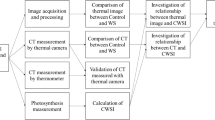Abstract
Field experiment was carried out on sandy loam soil with sorghum (cv. S-136), maize (cv. Ageti-76) and pearl millet (cv. PHB-14) during the summer season (may–July) of 1980 at Haryana Agricultural University Farm, Hisar. After one uniform irrigation at crop establishment, the crops were subjected to four irrigation treatments, viz. irrigation at ID/CPE (ID=irrigation depth of 7cm; CPE=cumulative pan evaporation) of 1.0, 0.6, 0.3 & 0.15. Changes in soil water potential (ψ soil), leaf water potential (ψ L), stomatal conductance (KL), canopy temperature (Tc), transpirational cooling (Canopy temperature minus air temperature, Tc-Ta), evapotranspiration (ET) and dry matter yields were recorded in different treatments. An increase in moisture stress resulted in a decrease in ψ soil, ψ L, KL, transpirational cooling, ET but increase in Tc. Tc-Ta showed significant curvilinear association with ψ soil and linear relationship with ψ L, KL, Tc, ET and dry matter yield of summer cereals. It is suggested that the mid day values of Tc-Ta as observed with an infra-red thermometer could effectively be used to sense the moisture stress effects in summer cereals.
Similar content being viewed by others
References
Blum, A., Mayer, J. and Gozlan, G., 1982. Intra-red thermal sensing of plant canopies as a screening thechnique for dehydration avoidance in wheat. Field Crops Res., 5: 137–146.
Chaudhari, U.N., Deaton, M.L., Kanemasu, E.T., Wall, g.W. Marcerian, V. and Dobrenz, A.K., 1986. A procedure to select drought-tolerant sorghum and millet genotypes using canopy temperature and vapour pressure deficit. Agron. J., 78: 490–494.
Ferguson, H., Eslick, R.F. and Aase, J.K., 1973. Canopy Temperatures of barley as influenced by morphological characteristics. Agron. J., 65: 425–428.
Fuchs, M. and Tanner, C.B., 1966. Infra-red thermometry of vegetation. Agron. J., 58: 597–601.
Hatfield, J.L., 1979. Canopy temperatures: the usefulness and reliability of remote measurements. Agron. J., 71: 889–892.
Phogat, B.S., Singh, D.P. and Singh, P., 1984. Responses of cowpea (Vigna unquiculata (L) Walp.) and mungbean (Vigna radiata (L.) wilczek) to irrigation. II. Effects on CO2 Exchange, radiation characteristics and growth. Irrigation Science, 5: 61–72.
Singh, D.P., Singh, P., Kumar A. and Sharma, H. C., 1985. Transpirational cooling as a screening technique for drought tolerance in oil seed Brassicas. Ann. Bot., 56: 815–820.
Singh, Piara and Kanemasu, E.T. 1983. Leaf and canopy temperatures of pearl millet genotypes under irrigated and non-irrigated conditions. Agron. J., 75: 497–501.
Tanner, C.B., 1963. Plant temperatures. Agron. J., 55: 210–211.
Towadros, F.E.M., 1977. Soil water functional relationship as influenced by soil physical and chemical characteristics of some soils of Haryana. Ph. D. thesis. H.A.U., Hisar.
Author information
Authors and Affiliations
About this article
Cite this article
Singh, B.R., Singh, D.P. Sensing of moisture stress effects by infra-red thermometry in sorghum, maize and pearl millet. J Indian Soc Remote Sens 16, 53–57 (1988). https://doi.org/10.1007/BF03014307
Issue Date:
DOI: https://doi.org/10.1007/BF03014307




